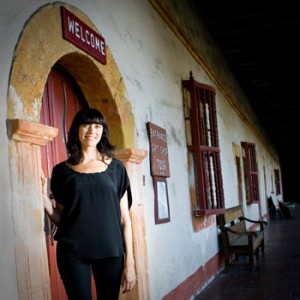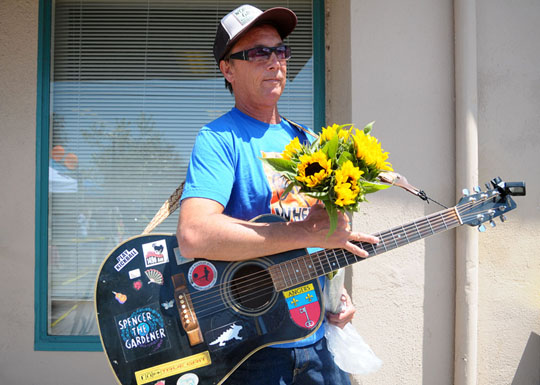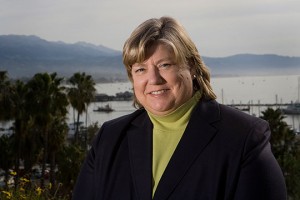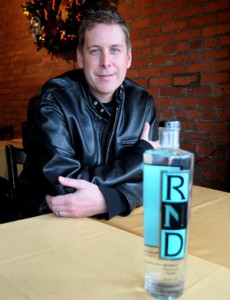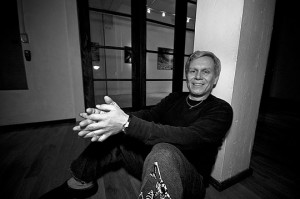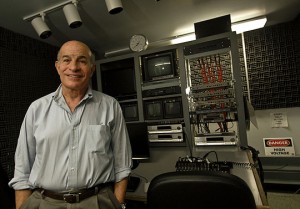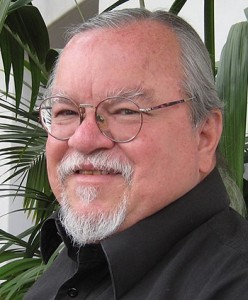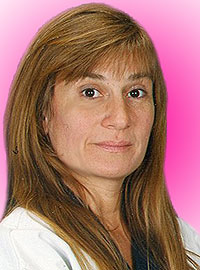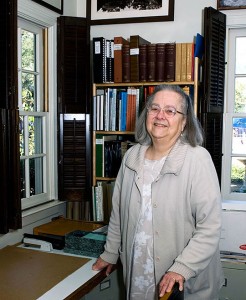
Paul Freeman, artistic director of the Santa Barbara Children’s Chorus, says there a number of reasons the community needs a children’s choir opportunity: “We had 60 or 70 kids audition and maybe 10 percent of them could sing well. Here are a bunch of kids who are clearly interested and they had all done musicals. They had all been doing all of the theater programs in town but none of them had been getting vocal training.” (Elite Henenson / Noozhawk photo)
Revival of program is first step in plan to give kids more chances to sing
The Santa Barbara Children’s Chorus is getting a gleeful reprieve, thanks to local
businessman Paul Freeman. He didn’t even know of the dormant choir’s
existence when he decided, several years ago, that Santa Barbara needed a
better choral program for children and that he should be the one to give it to
them.
“It was a back-of-mind, pet project/goal of mine for years and I’m excited to be
able to finally do it, and do it in a way where I don’t have to worry so much about
making money doing it,” explains Freeman, a UCSB graduate. He was a child
singer and sang and toured with the Golden State Boys Choir, studied voice with
Peggy Norcross and performed with the Santa Barbara Camarata Choir, UCSB
Men’s Chorus and Mixed Choir and the Santa Barbara Symphony.
As president and owner of Professional Development Partners, a business
consulting firm for high tech companies, Freeman is now in a position to give
back to the community, filling what he sees as a void in student’s musical
training. When Freeman and his wife Tracy–who both grew up in town–returned
to Santa Barbara in 2008 with their two sons (Cole, now 13, and Parker, age 9)
he joined long-time theater friend, Clark Sayre, and has been co-directing the
Spring musical at Dos Pueblos High School for the past two seasons, an
experience which further underscored the need for better music education in
town.
“The weakest area for the kids was singing. We had 60 or 70 kids audition and
maybe 10 percent of them could sing well,” says Freeman. “Here are a bunch of
kids that are clearly interested and they had all done musicals. They had all been
doing all of the theater programs in town but none of them had been getting vocal
training.”
He found that while there were many instrument programs in the elementary
schools, there were virtually no singing programs.
“The original plan was to start up a for-profit choir and then turn it into a nonprofit
once we got it up and running,” explains Freeman, who began teaching in 1984
as Assistant Artistic Director of the Santa Barbara Children’s Theater, where he
wrote and directed musicals “for children, by children.” He continued working with
the Children’s Theater after moving to Los Angeles in 1989, where he
established the West Valley Children’s Chorus, which he ran for several
years.
When he began doing research for the Santa Barbara project, Freeman
discovered the Santa Barbara Children’s Chorus, which was no longer active.
The timing to take over the nonprofit was perfect because it was “out of money
and out of momentum,” while Freeman and his team-which consists of himself
as Artistic Director, and Stephanie Hein Muench as Musical Director-were
ready to pick up the ball and run with it.
Winter session auditions for the non-denominational choir will be held between
10 a.m. and 1 p.m. on Saturday, December 11 at the Unitarian Society of Santa
Barbara, 1535 Santa Barbara Street. If children have an audition song they will
be asked to perform it. However, Freeman emphasized that “it’s an inclusive
group, meaning if you sign up you can get in. We want to make music available
to anybody. The audition process is to help us understand what their skill level
is.”
He is looking to target children in grades 4-8, to give them proper vocal training
before they get to high school. “It’s no secret that money for a lot of that stuff has
been cut. The schools that do have choral programs are funded through
fundraising by PTA or some other outside group. There is very little public
funding.”
Freeman applies his management skills to his plans for the chorus. “Long-term
there are three things that we want to do,” he says. “The first is a fee-based
program with scholarships available. The idea is to try to get anybody who comes
in regardless of skill level or economic situation, and the curriculum is a
combination of group singing, solo singing and music theory.”
The students will be exposed to an eclectic array of music. Inspired in part by the
popular TV series “Glee,” Freeman plans to start a performance choir summer
camp to help attract more kids to the program.
Once the classes get up and running, the plan is to start an all schools choir.
“This would be an outreach program to all the schools that are interested in
participating,” he explains. “We would hold in-school auditions and take five or
ten kids per school, depending on how many kids there are, at no cost to them.
… We would have one rehearsal a month during the school year and then put on
a big, all-school concert at a venue like the Santa Barbara Bowl, the Lobero or
the Arlington.”
The third phase of the evolution will be to develop what Freeman describes as a
music franchise program. “This is being done in other big cities, like Chicago
Children’s Choir has this killer program where they put choral teachers in the city
schools and they bring the whole curriculum of the main program into the schools
as little modules.”
This is clearly a project driven by passion for Freeman, a former professional
chef at some of Los Angeles’ top restaurants, who now serves on the Goleta
Valley Junior High PTA Board and coaches and referees AYSO soccer in his
“spare” time. An admittedly very driven and busy guy, he says, “I always get
asked how do I manage to do all that stuff and I don’t always know the answer.”
Freeman says, “These programs are going to take some time to roll out but the
message I want to get across to people is that there’s some meat on this idea of
what to do with the choir. It’s not like we’re just trying to get some classes
running and that’s it. We’d really like to make this more institutional. I have a lot
of attention on getting it to the point where it’s self-sustaining, where it’s not
reliant on one or two people to make the thing happen, because that’s what
happens in these groups. You see it all the time.”
When asked to come up with three adjectives to describe himself, Freeman says
he’s “optimistic, goal-oriented and creative,” all qualities which will serve him well
in his new choir venture. “It’s sort of a puzzle to figure out and I have pretty high
aspirations for it,” he acknowledges. “If I wasn’t running a business that was
dealing in very huge deals it might seem more challenging. A lot of people would
see this as a big project and a lot of challenges, but for me, compared to some of
the other stuff at work I’ve got going on right now, it’s pretty straightforward. I
feel like it’s doable.”
Originally published in Noozhawk on November 22, 2010.

